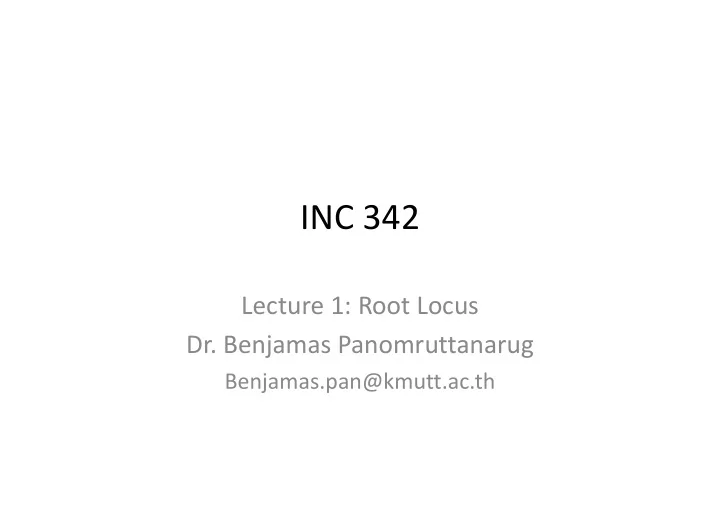

INC 342 Lecture 1: Root Locus Dr. Benjamas Panomruttanarug Benjamas.pan@kmutt.ac.th
DC motor BP INC 342 2
TF of DC motor 1 s K m V s L s R Js K a a a f K m 2 L Js R J L K s R K K K a a a f a f b m 10 6 10 6 (No load) J Approximate to the first order: L a K s m 2 V s L Js R J L K s R K K K a a a a f a f b m s K ( ) V s s s p 1 a BP INC 342 3
Stability and step response • What do you think about stability and step response from the system? s K ( ) V s s s p 1 a • How can we improve step response? BP INC 342 4
Camera man Object Tracking using infrared BP INC 342 5
Varying gain (K) Varying K, closed ‐ loop poles are moving!!! BP INC 342 6
Transient: • K<25 overdamped • K=25 critically damped • K>25 underdamped • Settling time remains the same under underdamped responses. Stability: • Root locus never crosses over into the RHP, system is always stable. BP INC 342 7
What is root locus and why is it needed? • Fact I: poles of closed ‐ loop system are an important key to describe a performance of the system (transient response, i.e. peak time, %overshoot, rise time), and stability of the system. • Fact II: closed ‐ loop poles are changed when varying gain. • Implication: Root locus = paths of closed ‐ loop poles as gain is varied. BP INC 342 8
Concept of Root Locus BP INC 342 9
Sketching Root Locus 1. Number of branches 2. Symmetry 3. Real ‐ axis segment 4. Starting and ending points 5. Behavior at infinity BP INC 342 10
1. Number of branches Number of branches = number of closed ‐ loop poles BP INC 342 11
2. Symmetry Root locus is symmetrical about the real axis BP INC 342 12
3. Real ‐ axis segment On the real axis, the root locus exists to the left of an odd number of real ‐ axis BP INC 342 13
( ) ( ) ( 2 1 ) 180 KG s H s k • Sum of angles on the real axis is either 0 or 180 (complex poles and zeroes give a zero contribution). • Left hand side of odd number of poles/zeros on the real axis give 180 (path of root locus) BP INC 342 14
Example root locus on the real axis BP INC 342 15
4. Starting and ending points Root locus starts at finite/infinite poles of G(s)H(s) and ends at finite/infinite zeros of G(s)H(s) closed ‐ loop transfer function ( ) KG s ( ) T s 1 ( ) ( ) KG s H s ( ) ( ) N s N s ( ) ( ) G H G s H s ( ) ( ) D s D s G H BP INC 342 16
( ) ( ) KN s D s ( ) G H T s ( ) ( ) ( ) ( ) D s D s KN s N s G H G H ( ) ( ) K=0 (beginning) poles of T(s) are D s D s G H ( ) ( ) KN s N s K= ∞ (ending) poles of T(s) are G H BP INC 342 17
Example BP INC 342 18
5. Behavior at infinity Root locus approaches asymptote as the locus approaches ∞ , the asymptotes is given by finite poles finite zeros a # finite poles # finite zeros ( 2 1 ) k a # finite poles # finite zeros 0 , 1 , 2 , ... k 19
Rule of thumb # of poles = # of zeroes K ( ) ( ) KG s H s ( 1 )( 2 ) s s s has 3 finite poles at 0 ‐ 1 ‐ 2, and 3 infinite zeroes at infinity BP INC 342 20
Example Sketch the root locus of the system BP INC 342 21
Example Sketch root locus ( 1 2 4 ) ( 3 ) 4 0 4 1 3 ( 2 1 ) k # finite poles # finite zeros / 3 , for k 0 , for k 1 5 / 3 , for k 2 BP INC 342 22
BP INC 342 23
Recommend
More recommend